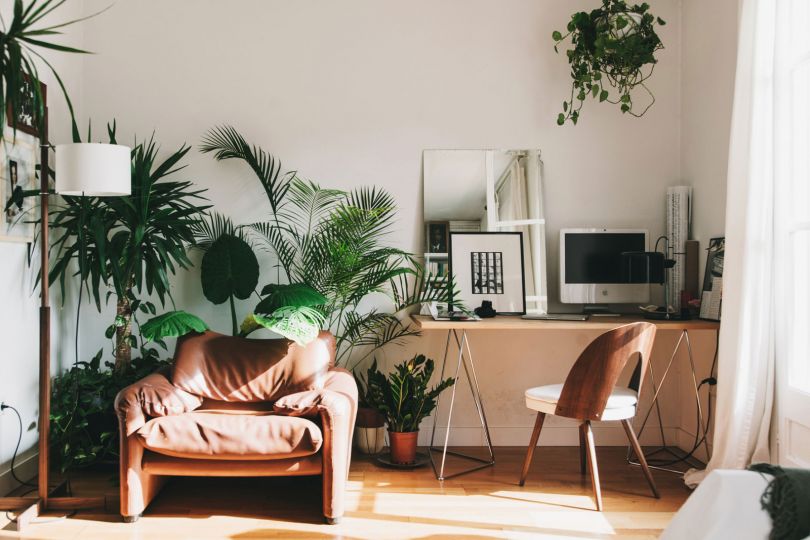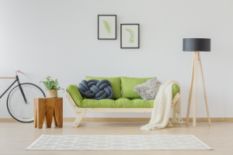Apartment Layout
 There are several foolproof rules that will help to even out the general picture: for instance, a small area with a low ceiling can be visually bigger if you put pots with tall plants. On the contrary, if the room has high ceilings, avoid placing pots with climbing plants or ones with leaves hanging from the pot. Plants help diving the living space into zones — thus, placing a large pot near the armchair and a coffee table creates a chill-out zone separated from the rest of the room. This is especially convenient for small apartments or studios.
There are several foolproof rules that will help to even out the general picture: for instance, a small area with a low ceiling can be visually bigger if you put pots with tall plants. On the contrary, if the room has high ceilings, avoid placing pots with climbing plants or ones with leaves hanging from the pot. Plants help diving the living space into zones — thus, placing a large pot near the armchair and a coffee table creates a chill-out zone separated from the rest of the room. This is especially convenient for small apartments or studios.
Interior
 Another important point is matching the flowerpots with the interior style of your apartment. If you are a fan of monochrome, buying bright pots in matching colors of accent points of the room may be a good idea. Provence and shabby chic-styled apartments give a way for creativity — for instance, making a DIY pot out of kitchenware like cups or tin and zinc buckets. If you aren’t sure about a definitive style or plan to change it soon, stick to the neutral solutions in calm pastel colors without patterns.
Another important point is matching the flowerpots with the interior style of your apartment. If you are a fan of monochrome, buying bright pots in matching colors of accent points of the room may be a good idea. Provence and shabby chic-styled apartments give a way for creativity — for instance, making a DIY pot out of kitchenware like cups or tin and zinc buckets. If you aren’t sure about a definitive style or plan to change it soon, stick to the neutral solutions in calm pastel colors without patterns.
Light
 Light is a crucial matter not only in terms of the style but for the long life of the plants as well. Check whether your windows are east-, west-, south-, or north facing. Each has unique features and suits various plants. For instance, east facing windows are best for growing fig trees and asparagus, west is good for placing begonia, eucalyptus and fuchsia, south facing windows suits cacti, citrus, aloe and coffee tree. The north facing window is often one of the most challenging directions to work with, as it doesn’t provide enough light for most plants. Dracaena, dieffenbachia, snake plant, ferns and ivy are the optimal solutions.
Light is a crucial matter not only in terms of the style but for the long life of the plants as well. Check whether your windows are east-, west-, south-, or north facing. Each has unique features and suits various plants. For instance, east facing windows are best for growing fig trees and asparagus, west is good for placing begonia, eucalyptus and fuchsia, south facing windows suits cacti, citrus, aloe and coffee tree. The north facing window is often one of the most challenging directions to work with, as it doesn’t provide enough light for most plants. Dracaena, dieffenbachia, snake plant, ferns and ivy are the optimal solutions.
Choosing Location
 Once you’ve determined the best green additions to the interior, it’s time to think through the exact location. On the whole, there are no strict rules but rather recommendations for each type of room. To start with the bedroom, make sure you don’t put too many flower or plant pots. Some flora tends to emit a strong aroma, which can cause migraines and even insomnia. Oxygen-producing aloe and succulent florariums are the best picks for the bedroom.
Once you’ve determined the best green additions to the interior, it’s time to think through the exact location. On the whole, there are no strict rules but rather recommendations for each type of room. To start with the bedroom, make sure you don’t put too many flower or plant pots. Some flora tends to emit a strong aroma, which can cause migraines and even insomnia. Oxygen-producing aloe and succulent florariums are the best picks for the bedroom.
Kitchen is usually the best lit area of the apartment. However, drastic temperature changes can seriously affect the plants. That’s why fig trees and aloe, which survive both the cold and intense heat, are the most suitable options. Artificial flowers or succulents can also add a nice touch to the kitchen.
Corridor, on the contrary, is usually the dimmest area of the apartment. Place bright sansevieria (also called snake plant), monstera and ferns — the latter can be placed in the handing pots and add a nice touch even to the plainest design.
Finally, the main room is an area of complete freedom. Keep the sun-loving plants near the windows and the rest in the shade, create zones with large and small pots — experimenting is welcome here. Designers often use the following tip: monochrome pots are best fitting bright and colorful plants. If you want to make a color accent, combinations of blue and white or yellow and blue are solid options.
Current Trends
Modern interior trends are created for and by those who often live in a small space and are short on time. That’s why, designers embrace plants that fit dim lightning and are quite easy to look after — to name but a few, dracaena, dieffenbachia and snake plant frequently appear on Pinterest and on the pages of the interior magazines. Succulents in all their variety are another on-spot trend.
The latest addition is florariums — geometrical glass pots that can fit a small garden. They fit well in monochrome and minimalistic interior thanks to their clean shapes. Ukrainian brand Roslynka specializes in florariums: 'houses' by Roslynka are made from glass, wood or concrete and host tiny succulents that are easy to care for. Florarium is a great gift for those who want to try themselves at gardening.
Photo sources: unsplash.com, casa.abril.com.br, pinterest.com. All images belong to their rightful authors.


















